Hair Sheep Breeds That Don’t Need Shearing
Most of us associate sheep with their woolly fleece, but in reality there are hundreds of different breeds of sheep and not all of them will boast a fluffy coat. If you have always wanted to raise sheep but are hesitant because of the need for shearing, you will want to look into the following popular “hair breeds”.
What are the top hair sheep breeds? There are several hair breeds of sheep, appreciated for their lack of shearing, resistance to external parasites, and adaptability to a wide range of climates. Ten of the most popular hair breeds of sheep are:
- Katahdin
- Barbados Blackbelly
- Dorper
- St. Croix
- Royal White
- Blackhead Persian
- Wiltshire Horn
- American Blackbelly
- West African Dwarf
- Red Maasai
If you are not interested in processing wool, you may find a hair sheep to be the low-maintenance choice for your flock. There are many productive hair breeds known for their meat, milk, and grazing abilities. Read on to learn more about the following popular hair breeds.
Top 10 Hair Sheep Breeds
Katahdin 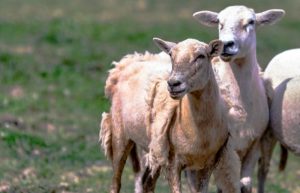
Katahdins are a popular breed of hair sheep and are easily found in most areas. They have short hair with a downy undercoat that can grow long and thick in colder climates and can be shed in warmer climates – this coat allows them the adaptability to live in many different regions, both Northern climates and hot or humid environments. Katahdins reach a mature weight of between 160 and 200 pounds and are often raised for their mild-tasting meat.
Katahdins originated in Maine in the 1950s when a man named Michael Piel set out to develop a breed of hair sheep that could be used for grazing and meat. At this time, there were no hair sheep in the United States, and after much research, he had three hair sheep shipped to him from St. Croix island.
After decades of cross-breeding, he was satisfied with the breed now called the Katahdin (after the tallest peak in Maine) in the mid-70s. Katahdins today can be found almost anywhere in the United States and are preferred by many keepers for their docile temperament, high prolificacy, and carcass.
Barbados Blackbelly 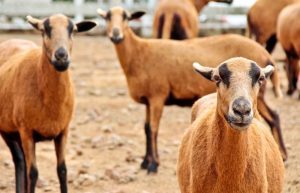
The Barbados Blackbelly is a small-medium breed that is covered in short, thick hair. They are usually tan in color with black markings along the legs, head, and belly (hence the name). Mature Blackbellies usually weigh between 90 and 120 pounds and are known for their mild flavor of meat.
The history of this breed is unclear; however, it is widely accepted that they originated from Barbados as a cross between African hair sheep and a European wool sheep. The belief is that when Europeans originally settled in the area, the wool sheep that they brought with them were not well-suited for the tropical climate. In crossing them with African hair sheep, they developed the Barbados Blackbelly – a small, meaty hair sheep well-designed for the warm and humid environment.
There are hundreds of thousands of sheep in the US that have benefited from the genes of the Barbados Blackbelly, but only around 400 purebreds can be found in the country today.
Dorper 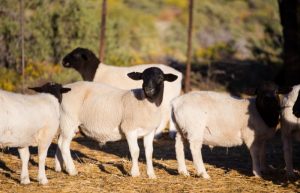
Dorpers are not wholly a hair breed, as their coat is actually a combination of both hair and wool. They are, however, just as low-maintenance as any other hair breed because the fleece will shed without intervention each year, eliminating the need for shearing. Dorpers are considered a “mutton breed” and are large in size with white bodies. 80% of Dorpers have black heads, while the other 20% have white heads. They are prized for their especially thick skin, with the lambskin of a Dorper estimated to be around 20% of the total value of the carcass.
Dorpers originated from South Africa in the 1930s by crossing the Dorset Horn with the Blackhead Persian. They are highly fertile and are able to thrive on low-quality forage. They are adaptable to a range of climates and do exceptionally well in dry, arid conditions.
St. Croix
The St. Croix, also called the Virgin Island White, is typically all-white in color and is of medium size (around 120-160 pounds at maturity). They are a hair breed, originating from the Virgin Islands. Because of their tropical origin, they are a good choice if raising sheep in a warm, humid climate. They are highly resistant to parasites and are known to be docile and easy to handle.
Twenty-five St. Croix (22 ewes and 3 rams) were imported into the United States from the Virgin Islands in 1975 and are the basis for those available in the US today. While they are often used in cross-breeding, there are several private breeders who breed pure St. Croix today, making them fairly easy to find.
Royal White
The Royal White is a relatively new (and promising) breed, developed in the mid-1990s in Texas by crossing the St. Croix and the Dorper. The result was a large breed, maturing to 180-260 pounds, and all-white in color. Royal Whites grow a longer coat of hair in the Winter, which is naturally shed in the Spring. The Royal White has been undergoing improvement in disease resistance and meat efficiency by various universities in Texas.
Blackhead Persian 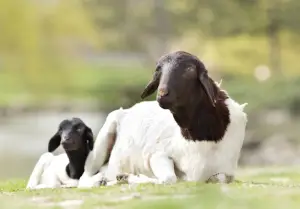
The Blackhead Persian is a smaller breed of sheep originating from what is now known as Somalia. They have white bodies with black heads (where the Dorper got its coloring), are naturally polled, and are smaller in size – averaging between 65 and 110 pounds at maturity.
The Blackhead Persian is a fat-tailed sheep prized for the cooking fat that makes up a high percentage of the carcass value. This breed does well in both dry, arid climates and hot, humid climates.
Wiltshire Horn 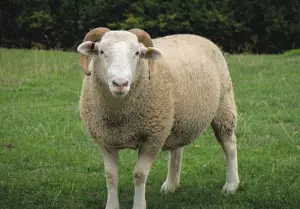
The Wiltshire Horn is an ancient breed from the UK, with a handful of breeders in the United States. They are of medium size, around 150-250 pounds, and are all white in color. They have no wool – growing a thick coat of downy hair in the Winter, which they shed in the Spring. Both males and females have horns, with females having short backward-curving horns and males having thick, spiraling horns.
These horns can, at times, grow too close to the jaw – it is important to keep an eye out for this so that they can be shaved down or cut if they are pressing into the sides of the face. Wiltshire Horn sheep can do well in both dry, hot climates and Northern climates. They are resistant to most external parasites and are generally easy keepers.
American Blackbelly 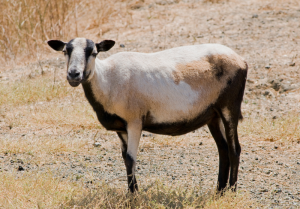
The American Blackbelly was developed by crossing the Barbados Blackbelly with the Mouflon. The resulting offspring had large horns – so large that they interfered with the jaws of the sheep. For this reason, they were again crossbred with additional Mouflon, opening the space between the horns and perfecting the breed.
This breed is medium in size, tan with black markings, and has a thick hair coat. What makes the American Blackbelly stand out is the beautiful spiral horns that are grown by the rams. While American Blackbellies are gaining popularity as a gourmet meat breed, they have historically been bred for their “trophy horns”. They are bred on ranches as a sporting breed, hunted and prized for their horns.
West African Dwarf
The West African Dwarf is a breed that is used primarily for meat in South, West, and Central Africa. This breed goes by several other names, including Cameroon Dwarf, Nigerian Dwarf, Forest-type, Savannah-type, and West African Maned. They are a small breed, weighing only 50-80 pounds, and the males usually have horns. West African Dwarf sheep have a hair coat – usually of black and white coloring, but can also be found in tan and white or solid colors – and the males have an impressive mane of hair on the neck and chest.
Red Maasai 
The Red Maasai is a reddish-brown hair sheep that can be found in Tanzania, Kenya, and Uganda. They are a fat-tailed variety and are primarily raised for their meat. While they can be harder to find in other countries, they are prized by small farmers and homesteaders for their exceptional resistance to external and internal parasites, hair coats, and sweet milk and meat.
The Convenience Of Hair Sheep
Hair sheep breeds are a convenient and low-maintenance choice for those farmers or homesteaders not looking to market wool. In addition to the lack of shearing, most hair breeds have shorter tails, eliminating the need to dock in many cases. Wool, while a highly valuable commodity, attracts dangerous parasites, is easily soiled, and leaves an animal susceptible to hot weather. If you would like to raise sheep but are not interested in profiting off of the wool, you can’t go wrong with one of the hair breeds listed here.
